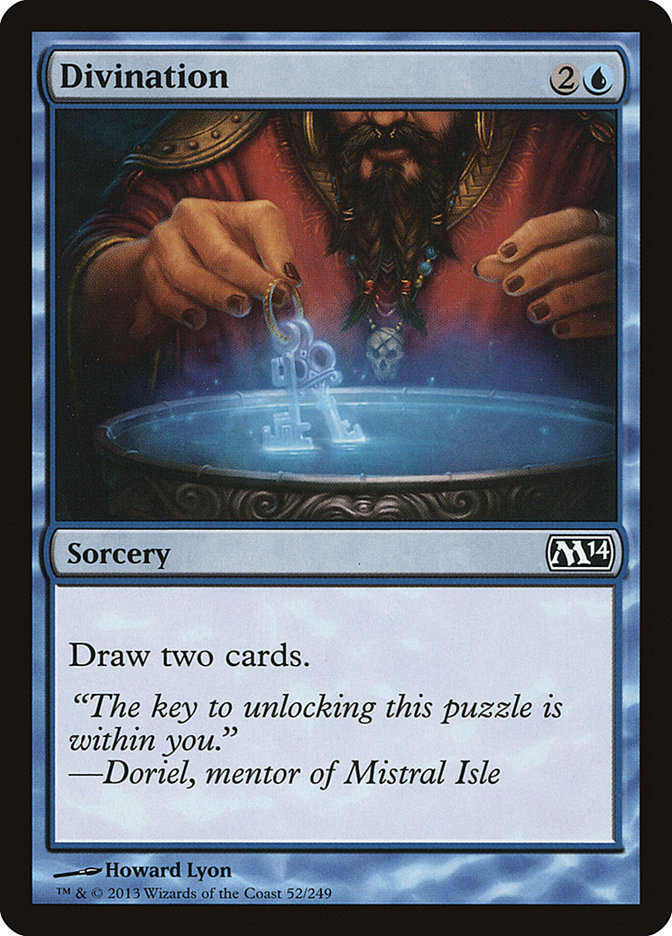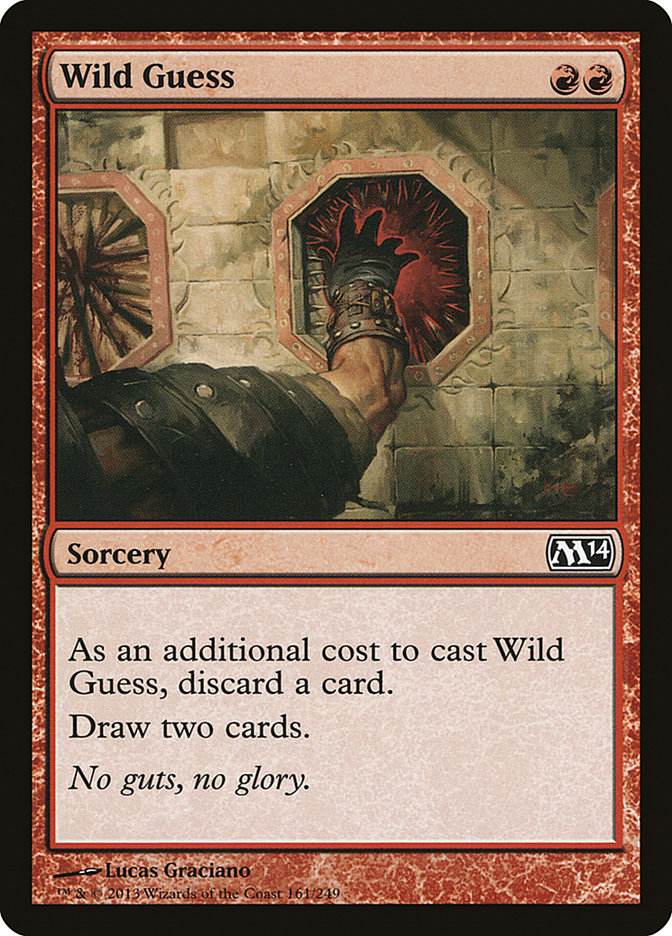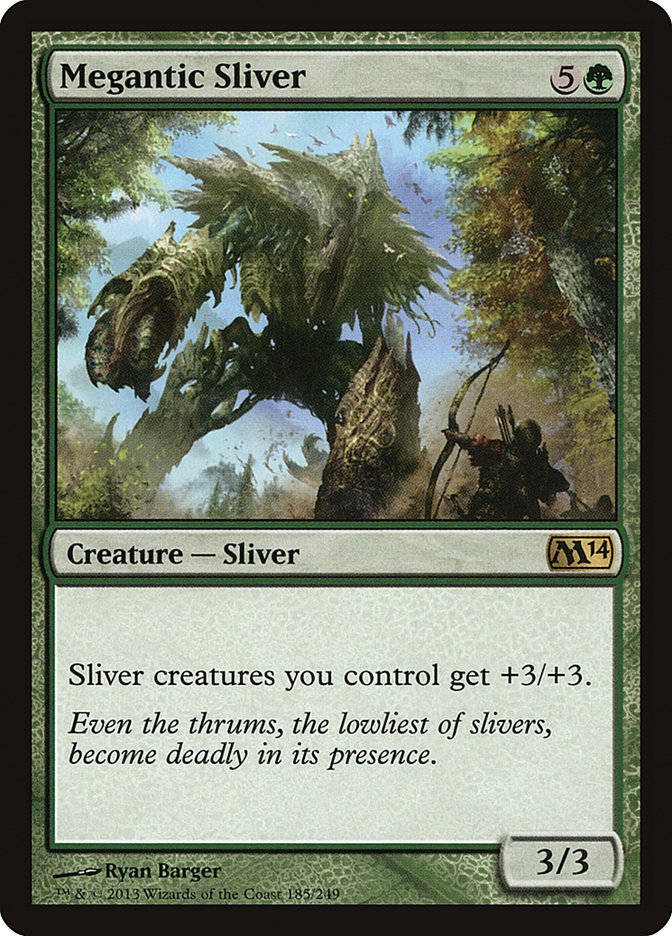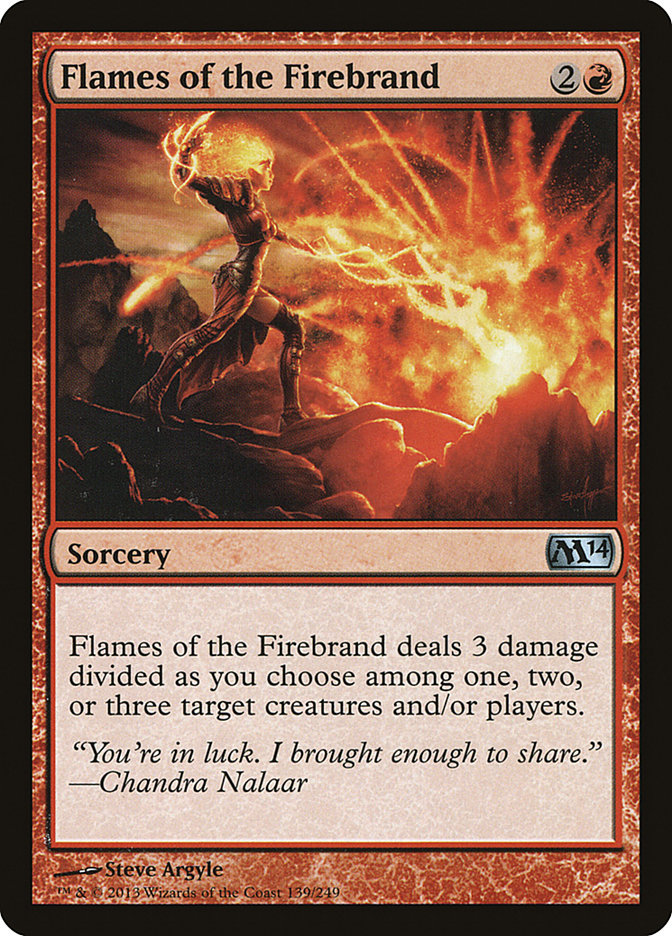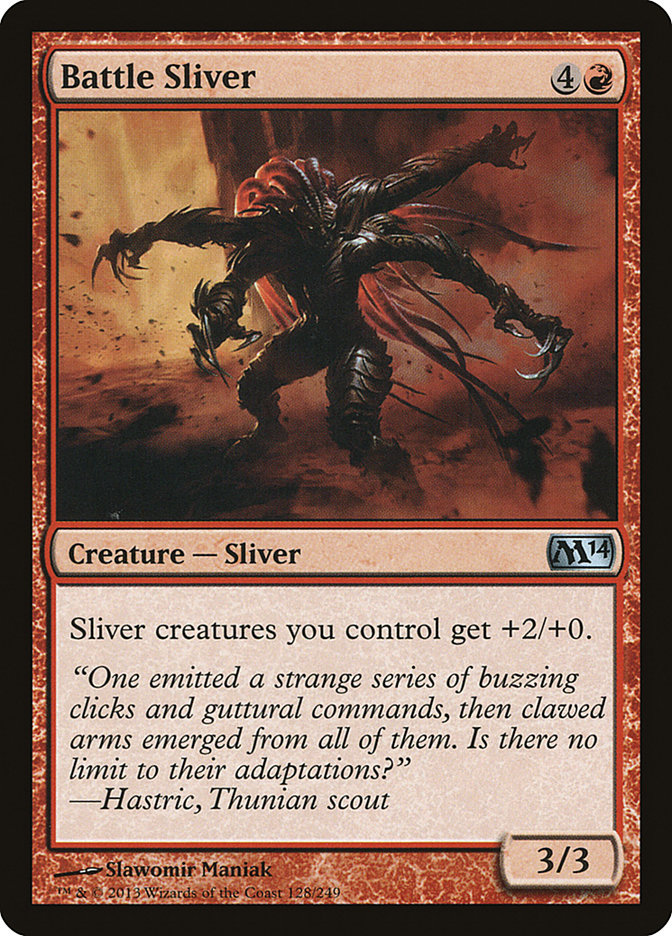Most of you see my name and think to yourself “here comes another control article.” For some that brings joy, and for others that enjoy a good Rakdos Cackler, it brings boredom. I’ve done pretty well on the Constructed scene, especially in Legacy. My expertise from which I derive the most success, however, is in Limited.
Everyone loves to draft. Some prefer Cube, while others like to stay current with the current Limited format, but we all enjoy putting together 40-card decks to battle with. I’m a product of my tournament environment. Since Draft Opens no longer exist, I have slacked off as of late. I have spent my free time staying up to date with Standard and Legacy, leaving Limited in the cold until recently. Modern Masters was simply too much fun to skip, and now I’ve made it a mission to stay up to date so that I can write a couple of articles like these and try to lend a helping hand to my readers.
M14 is pretty entertaining; ever since Avacyn Restored, the Draft formats have been pretty fun. With M14, people get the base-set goodness with a little added synergy (more so than most base sets of the past contained). There are clear archetypes that become evident after a few drafts, but there are subtle ones that can be missed by the most grizzled of veterans. Since it is a core set, you are realistically allowed to combine any two colors, create a deck that is coherent, and achieve victory.
The rules of engagement compared to the more complex block drafts are much different here. We have to get out of the guild mindset and pay heavy attention to signals in order to have M14 Draft success. Lower card strength, less complexity, a harsher punishment for forcing, and the difficulty of drafting more than two colors are some of the traits that make M14 different from block drafting.
Card Strength and Synergy
Determining card strength is one of the most difficult things to do in Magic. What makes one card better than another? Is Claustrophobia better than Scroll Thief? I think so. Is Rumbling Baloth better than a Briarpack Alpha? Not a chance. Similar to most Limited formats, removal is the key in M14. I don’t care how good someone’s creatures are. At some point, one will have to stop a creature with Mark of the Vampire on it or their army of efficiency will be defeated with ease. This is easier than before with cards like Time Ebb, Hunt the Weak, Celestial Flare, and the slew of other removal spells at our disposal. Since M14 moves at a snail’s pace, determining card strength is slightly different than previous formats.
Let’s keep this simple. Since the format is slow, a person has time to do anything, so pick cards regardless of their speed. As I mentioned, Divination is a house, and even cards like Wild Guess have their place. At the end of the day, it is about the quality of someone’s cards versus their opponent’s.
I love a good Elvish Mystic into Scroll Thief into Time Ebb as much as the next person does. Tempo and speed still exist and there are some G/R and R/W decks that can easily win, but it is a lot less frequent in this format than others. A lot of us look at a card like Opportunity and know it’s a great card but don’t understand all the reasons it’s a first pick in Limited. Opportunity is much better in a base set than it would be in others because of the lower power level. I see a lot of stalled or slowed games in M14, grinding out card-for- card, which makes casting an Opportunity nearly unbeatable unless a person is way behind. For that same reason, cards like Divination are also great in M14, and I draft them regularly.
When discussing card strength and synergy and then implementing what we have learned, the natural combination of colors in M14 tends to be U/B. This doesn’t mean people should go out and force the two colors. The combination of removal and card draw in a slow format is an unstoppable force. I have slain the best M14 bomb decks with mediocre U/B decks repeatedly online, and it tilts my opponents to no end. Cards like Gnawing Zombie, Corpse Hauler, and Scroll Thief hold down the fort in the early game while I sit back and draw cards until I’m blue in the face (no pun intended). The late cards usually involve powerful flash flyers (Nephalia Seakite), intimidate creatures (Accursed Spirit), and a ton of removal to back it up.
A lot of the U/B uncommons play like rares as well. Opportunity, Blightcaster, Air Servant, and Sengir Vampire all impact the game in very powerful ways. The black and blue removal / tempo suite of Claustrophobia, Doom Blade, Quag Sickness, Liturgy of Blood, Wring Flesh, Sensory Deprivation, Time Ebb, and Disperse combined with Archaeomancer is too compelling to stay away from usually.
On the topic of card strength, we have to dive right into the removal / card draw pool if the water is warm and the colors are available. Trust me, you won’t be disappointed. Sometimes there is no correct answer for a card strength debate between two cards. This fact is hard for me to process at times because I always have an opinion in terms of which would be better between two random cards, but in the end that is my opinion. People often get asked which card is better “pack 1 pick 1.” In certain cases, someone is just wrong, and there is a significantly more powerful card. In others, it is completely dependent on support cards that follow. In these scenarios, I like to call one a “safe pick” and the other a “risky pick.” For example, let’s say you open a pack with these two cards:
Taking a first pick Megantic Sliver over a Flames of the Firebrand isn’t wrong. There are times where Megantic Sliver will lead to the promised land. Other times no Slivers will show up, and you’ll left with it in your sideboard. The “safe pick” here is Flames of the Firebrand, but you can make an argument all day for taking the monstrous Sliver.
The previous example happens a lot in this format, so I have an idea that can give everyone the feedback that would be most practical instead. At the end of this article, if there is a card vs. card question, please ask. I will not only answer the question but give my reason for doing so. If a person is more comfortable with email, that’s fine as well. My goal is to create an army of efficient drafters that one day revive the Draft Opens!
After snagging a few card-draw spells, one is going to want to scoop up spells that synergize well with them. Optimal plays aren’t Dragon Hatchling into Divination. Card draw is best suited with removal and, of course, Archaeomancer. Archaeomancer looks to be a weak Eternal Witness at first glance, and if judged by its card strength, its rating would be low. It turns out that the 1/2 regrowth Human is one of the best possible cards to have in a U/x control or tempo deck.
There is no better feeling than to rebuy an Opportunity, Doom Blade, or counterspell a bit later in the game. Sequences like a turn 3 Mind Rot, turn 4 Archaeomancer returning the discard spell, and recasting it on turn 5 are quite powerful in such a slow format. Archaeomancer allows one to do what is best suited at the time, and since there are so many good instants and sorceries in U/B, it often leads me to follow that combination for maximum efficiency and synergy.
The most obvious synergy in M14 is Slivers. Slivers pack a punch in green but also get a great deal of reach from the red side. Since the mediocre rare Slivers are in blue and black, it’s rare to have the urge to dive into those colors with the intent to draft Slivers. I have found myself splashing in my G/W or G/R Sliver decks, but I’m usually sticking to two colors in this format. The Slivers work extremely well together because they don’t boost the opponent’s and because base sets (this one included) have a great deal of vanilla creatures. Since there are so many vanilla creatures around, Slivers really stand out and tempt people to dive right in.
I have no issue with first picking a Battle Sliver, grabbing a couple Hive Stirrings, and never looking back. The trick is judging signals to ensure being seated far from someone who has the same strategy. It’s easy to draft a U/B deck or a U/G deck with someone sitting nearby doing the same. With Slivers, however, that is typically not the case. The packs usually contain zero or one potent Sliver that is essential to building a powerful tribal deck. Most of the time a person can have as many Hive Stirrings, Sliver Constructs, and Striking Slivers as they’d like, but the real power is derived from having at least a couple Battle, Predatory, or rare slivers that boost the damage dealt. In the end, I truly believe that if you get the right signal, Slivers are unstoppable.
Most drafts that I attend without dropping a match involve a couple powerful Slivers in G/W, R/G, or R/W. The R/W version of the Sliver deck requires a different strategy than picking up just a bunch of Predatory Slivers. With this Sliver deck, scoop up Sentinel Slivers, Treeform Slivers, Hive Stirrings, Blur Slivers, and Striking Slivers like you would when building any tribal-themed deck. The difference is Battle Slivers are usually tougher to come by than Predatory Slivers due to them being an uncommon.
I do not like Fortify in this format at all in almost every build of every deck except in this one. Fortify is the bomb of this deck and allows for a complete blowout in blocks because Slivers have higher toughness, vigilance, and first strike in the middle of the game. It also allows a finisher for a small army created that may have a hard time finishing the job or even connecting due to large opposing creatures.
Not only is Fortify a bomb in this deck, but it is essential for victory and should be drafted highly. Many would make the mistake of expecting it to table and take a second Blur Sliver over it pick 3, but that could result in a disaster. In decks as fragile as R/W, be sure to have the necessary pieces before strengthening numbers unless it is very early in the drafting (pack 1).
There are multiple other synergies in M14 Limited that can be utilized. Advocate of the Beast has a few monsters that can be paired to give opponents nightmares. Mutavault and Garruk’s Horde are a couple fun rares with it, but Kalonian Tusker and Rumbling Baloth are just fine as well. The best part is that all of the cards are insane by themselves and can crush opponents without any help.
Advocate of the Beast being a 2/3 is a pretty big deal. 2/3s in M14 stop nearly every early rush that doesn’t have a combat trick to push through. Another powerful synergy with just a vanilla 2/3 is Mark of the Vampire. If someone is playing against G/R and marks a 2/3 with vampire power, they’re going to have a very hard time winning. Having outs like Hunt the Weak and a Volcanic Geyser won’t cut it when playing a fourth land.
Auras have gotten a lot better in M14. There are a lot of Auras that if not answered immediately can easily put a game out of reach for the opponent. The synergy between creatures and Auras is an obvious one, but the true synergy is in the power that they create in comparison to times passed. Lightning Talons, Trollhide, Shiv’s Embrace, and Mark of the Vampire are just so potent that they leave defending creatures too weak to stop them. I’d usually stay away from Divine Favor and Dark Favor because just as in times past they are pretty bad.
All Auras allow for card disadvantage, but it’s worth the risk if an opponent is dead if it goes unanswered. Cards like Blightcaster and Ajani’s Chosen increase the power of enchantments as well. Auramancer is garbage outside of the black decks, but combined with Quag Sickness it is a nightmare to play against. The synergies are built into M14 pretty effectively, and I’m sure most who have drafted can appreciate the things accomplished in matches.
Signals in Drafting
This section is more of a help guide for all draft formats, not just M14. In M14, reading signals is more crucial than in formats that have more multicolor opportunities. People might draft more than two colors in M14, but tell them to read this article and point out that I said that it’s madness. When I’m green, I might splash a Flames of the Firebrand, but you will not catch me playing a Darksteel Ingot with two Swamps and a Shimmering Grotto.
Since we are keeping it to two colors, we have to be sure the person to our left isn’t syphoning both of our colors. The common pools for green and blue are deep enough to share with someone directly passing to us, but the other colors will struggle. There are only so many Chandra’s Outrages and Pacifisms to go around, and a player can’t afford to be the one with Siege Mastodons and Canyon Minotaurs galore. Since nearly every green and blue common is playable, (ignoring some of the one-drops), players have the opportunity to draft a strong deck regardless of who shares the color. That is where signal skill comes into play.
When looking for signals, you must be aware that these big core sets can have a different set of commons in each pack. A signal in base sets comes around pick 5-6 and is usually not an obvious card. There are times where you get that seventh pick Battle Sliver and are clearly the only one eyeing that strategy, but for the most part you’ll see a late Divination or Hunt the Weak and it’s time to shift gears. Up until the middle of pack 2, I think it’s perfectly fine to jump into another color that you see if it’s fully available.
This doesn’t mean you have zero blue cards going into pack 2 and see an Opportunity and Claustrophobia and jump for joy; it means you had a couple blue cards come semi-late in pack 1. You may have snagged those blue cards pack 1 or shipped them right along, but clearly the guy didn’t bite and now you have the remainder of pack 2 to clean up with the promise of pack 3 being bountiful in that color.
Reading signals isn’t something you just perfect overnight. It varies from format to format, but the rule of thumb is watch for the decent cards that come your way late and not for the bombs you were passed pick 2. Sometimes in Limited your opponent will open a foil rare and a rare and take one, passing the slightly weaker one. Sometimes your opponent simply makes the wrong pick and misjudges card strength but is still fully in your strategy. These are things you need to keep an eye out for. That’s why the cards that come later had to go through multiple people.
I would argue that knowing how to read signals is the most important draft skill to pick up. The ability to ditch an entire color and take a gamble with a signal is a scary proposition. Most drafters are unwilling to try and will say things like “I just got passed nothing!” or “everyone is in my colors!” and will lose swiftly in the early rounds. If you are reading this and have had those thoughts on more than one occasion, then I implore you to jump ship the next time things are drying up for you in a color; you will see a huge difference in the quality of your deck.
The reason why being stubborn in your two colors worked well in Ravnica block is because since you are three colors most of the time, you can deal with an opponent being in one or even two of them because you can capitalize on the third color when they pass to you and you are in the clear when the packs are going the other way. In M14, you should be two colors, trust me.
I think WotC did a great job with M14 when we look at previous base set Draft formats. It seems like they got their act together with the last few sets, and I’m expecting another well-designed format in Theros. In M14, or in any draft you queue up for, just remember the tips given to you in this article and in others you’ve read. It is perfectly fine to jump out of a color even after the first pack has concluded. The key is to keep your eye open for subtle and decent cards still lingering at the end of pack 1.
Don’t be fooled by the second-pick monster you see; consider the possibility of two monsters being opened in that pack or that the person passing to you isn’t the greatest Limited player. More so in other formats than in M14, you shouldn’t just throw a bunch of cards that share the same color together but rather search for synergies that can advance you farther than a decent curve. Synergy is simple to achieve in Constructed and more of an art in Limited. In Limited, you understanding card interaction against an opponent who is clueless is enough to give you a significant edge when battling for a Draft championship.
I hope this article helps you in Limited. I truly find it more challenging to convey my thoughts on the subject compared to my control ranting. One of these days I will learn technology and give you guys some videos to see and hear me more efficiently. Please remember to give me some pick vs. pick scenarios at the bottom, and I will defend my position to the best of my ability!
Shaheen
Twitter – @shaheenmtg
Email – [email protected]

